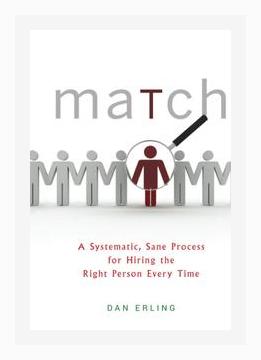Human Resources and Talent ManagementRecruitment and Hiring
**
Introduction
“Match” by Dan Erling provides a comprehensive guide on refining the hiring process. It ensures that recruiters and hiring managers can systematically identify suitable candidates, reducing turnover and enhancing organizational performance. Erling discusses the typical pitfalls companies face, and offers a structured approach to avoid them.
1. Understanding the Hiring Problem
Erling begins by highlighting the common mistakes made in the hiring process such as bias, relying on gut feelings, and misalignment of job expectations. He explains that traditional methods often lead to mis-hires which are costly both financially and in terms of team morale.
Action Step: Conduct a retrospective analysis of past hires to identify patterns or recurring issues in your hiring process. Document these findings to inform future improvements.
Example: Erling illustrates the story of a technology company that consistently hired based on résumé credentials without evaluating cultural fit, resulting in many quick turnovers.
2. Preparation Before Hiring
Erling stresses the importance of preparation. He advises creating a detailed job description that includes not just skills and qualifications, but also character and cultural fit.
Action Step: Develop a comprehensive job description that outlines essential skills, desired attributes, and cultural aspects of the organization.
Example: In one case, Erling showed how a retail company revamped its job descriptions to clearly state the importance of customer engagement skills, leading to better recruitment outcomes.
3. Formulating a Recruitment Plan
The book suggests forming a structured recruitment plan involving multiple stages such as sourcing, screening, interviewing, and hiring. Each stage should have clear objectives and methods to assess candidates.
Action Step: Create a recruitment plan that details each step of the hiring process. Assign responsibilities and decide on tools or systems needed for each phase.
Example: Erling refers to a manufacturing firm that implemented a multi-stage plan including an initial phone screen, a technical assessment, and a final cultural fit interview, reducing their mis-hire rate by half.
4. Sourcing Candidates
Erling advises using a variety of sourcing methods such as job boards, social media, employee referrals, and recruitment agencies. He emphasizes the importance of active and passive talent pools.
Action Step: Diversify your sourcing channels to include online platforms, referrals, and networking events. Develop a strategy for engaging passive candidates.
Example: A consultancy firm expanded their sourcing to include LinkedIn outreach and university career fairs, resulting in a richer and more diverse candidate pipeline.
5. Screening Resumes Effectively
Erling suggests using a scorecard to screen resumes, evaluating them against the job requirements and key competencies outlined in the job description.
Action Step: Create a resume scorecard based on the job description criteria, rating each application consistently.
Example: A software development company used a scorecard method to screen candidates, which significantly reduced the time spent reviewing resumes and increased the quality of candidates moving forward.
6. Conducting Structured Interviews
Erling advocates for structured interviews to ensure consistency and fairness. He recommends using a mix of behavioral and situational questions to evaluate past performance and potential.
Action Step: Develop a set of standardized interview questions tailored to the role. Train interviewers on how to use these questions effectively.
Example: A healthcare organization implemented structured interviews with scenario-based questions, which improved their selection accuracy for frontline healthcare workers.
7. Using Behavioral Assessments
Adding behavioral assessments to the recruitment process can provide insights into a candidate’s work style and predict cultural fit. Erling discusses various tools available for this purpose.
Action Step: Incorporate a behavioral assessment tool into your hiring process. Ensure that the tool is validated and relevant to the job role.
Example: An advertising agency introduced a behavioral assessment to screen for creativity and teamwork, which led to higher levels of employee engagement and retention.
8. Checking References Thoroughly
Erling emphasizes the importance of thorough reference checks to verify a candidate’s past performance and behavior.
Action Step: Develop a robust reference checking process. Engage in open-ended conversations with referees to gain deeper insights.
Example: A financial services firm implemented a structured reference check protocol, which helped them confirm candidate credentials and detect any red flags early on.
9. Making the Final Decision
Erling advises that the final hiring decision should be based on a combination of interview performance, behavioral assessment results, and reference checks. He suggests using a decision matrix to objectively evaluate each candidate.
Action Step: Create a decision matrix that weights different criteria such as technical skills, cultural fit, and assessment scores. Use this matrix to guide the final decision.
Example: A logistics company adopted a decision matrix approach, which provided more objectivity and led to more consistent hiring decisions.
10. Onboarding New Hires
Effective onboarding is crucial to integrate new hires successfully and ensure they become productive members of the team.
Action Step: Develop a structured onboarding program that includes orientation, training, and regular check-ins to assist new hires in transitioning smoothly.
Example: A marketing firm introduced a detailed onboarding program with mentorship, which significantly reduced the learning curve for new employees and improved retention rates.
Conclusion
Dan Erling’s “Match” is a vital resource for businesses looking to optimize their hiring process. By following a systematic and structured approach, companies can significantly reduce the risk of mis-hires and build a more cohesive and effective workforce.
By applying steps such as developing detailed job descriptions, diversifying sourcing channels, using structured interviews and creating decision matrices, organizations can ensure they hire candidates who are not only skilled but also a good fit for the company culture.
Overall, the book emphasizes the importance of preparation, evaluation, and structured processes in hiring, offering practical tools and examples for implementation.
Summary (Approx. 1500 words)
